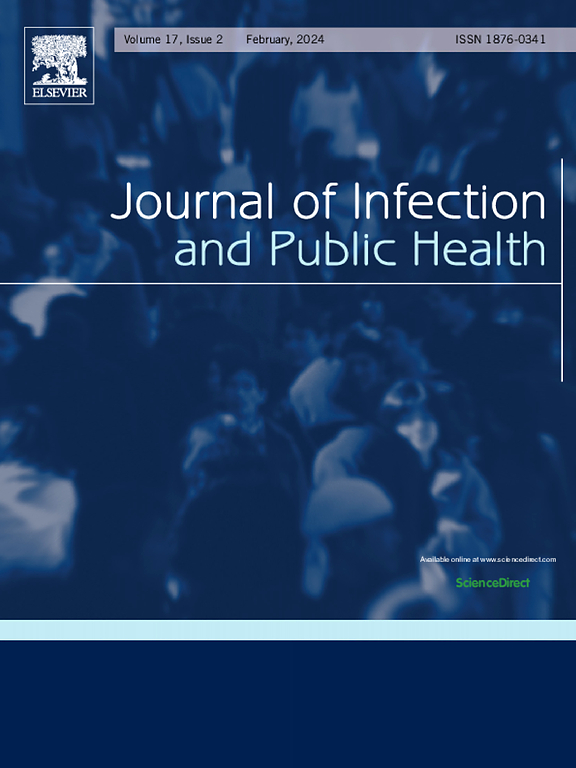Impact of mutations in immunodominant regions of SARS-CoV-2 variants on recognition by CD8+ T cell: An in silico analysis
IF 4.7
3区 医学
Q1 INFECTIOUS DISEASES
引用次数: 0
Abstract
Background
This study aimed to investigate whether mutations in the immunodominant regions of the S, M, and N proteins of the Gamma, Delta, and Omicron SARS-CoV-2 variants that circulated in Brazil affect the recognition of viral antigens by Brazilian HLA-I-restricted CD8+ T cell epitopes, using an in silico approach.
Methods
Sequences of the Gamma (n = 36,174), Delta (n = 35,129), and Omicron (n = 336) variants were retrieved using GISAID. Consensus sequences were generated using Geneious software with NC045512 as a reference. Epitopes for the S, M, and N proteins of both the original and variant sequences were predicted using NetCTLpan 1.1, NetMHCpan 4.0, and VaxiJen v2.0. The positions occupied by these epitopes, with high probability of presentation, affinity to HLA molecules, and antigenicity, were identified as potentially immunodominant regions.
Results
The S protein of the reference sequence (NC045512) and its variants contained 17 immunodominant regions. Delta showed the highest conservation (94.1 %, 16), followed by Gamma (82.3 %, 14) and Omicron (70.5 %, 12). Omicron exhibited the greatest mutational variability and had regions of increased antigenicity and two novel immunodominant regions with broader human leukocyte antigen (HLA) recognition. Additionally, Omicron lost two previously identified immunodominant regions and had one region of reduced antigenicity that did not affect HLA recognition. Gamma had mutations in three regions that increased both antigenicity and HLA recognition. Delta had only one mutated region with lower antigenicity, which did not affect HLA recognition. Notably, new immunodominant regions for the M and N proteins appeared in the Omicron variant.
Conclusions
Brazilian HLA-I-restricted CD8+ T cell epitopes from SARS-CoV-2 immunodominant regions are partially conserved in the Gamma, Delta, and Omicron variants circulating in Brazil, suggesting effective a cross-protective immune response that may help reduce COVID-19 severity and mortality.
SARS-CoV-2变异体免疫优势区突变对CD8+ T细胞识别的影响:计算机分析
本研究旨在研究在巴西流行的Gamma、Delta和Omicron SARS-CoV-2变异体的S、M和N蛋白免疫优势区突变是否影响巴西hla - i限制性CD8+ T细胞表位对病毒抗原的识别。方法使用GISAID检索Gamma (n = 36,174)、Delta (n = 35,129)和Omicron (n = 336)变异序列。以NC045512为参考,采用geneous软件生成一致性序列。使用NetCTLpan 1.1、NetMHCpan 4.0和VaxiJen v2.0对原始序列和变异序列的S、M和N蛋白的表位进行预测。这些表位所占据的位置,具有高呈递概率,对HLA分子的亲和力和抗原性,被确定为潜在的免疫优势区。结果参考序列NC045512及其变异的S蛋白包含17个免疫优势区。Delta的保守性最高(94.1 %,16),其次是Gamma(82.3 %,14)和Omicron(70.5 %,12)。Omicron表现出最大的突变变异性,具有增加的抗原性区域和两个新的免疫优势区域,具有更广泛的人类白细胞抗原(HLA)识别。此外,Omicron失去了先前鉴定的两个免疫优势区,并且有一个抗原性降低的区域,不影响HLA识别。γ在三个区域发生突变,增加了抗原性和HLA识别。Delta只有一个抗原性较低的突变区,不影响HLA识别。值得注意的是,在Omicron变体中出现了新的M和N蛋白的免疫优势区。结论来自SARS-CoV-2免疫优势区的巴西hla - i限制性CD8+ T细胞表位在巴西流行的Gamma、Delta和Omicron变体中部分保守,表明有效的交叉保护性免疫应答可能有助于降低COVID-19的严重程度和死亡率。
本文章由计算机程序翻译,如有差异,请以英文原文为准。
求助全文
约1分钟内获得全文
求助全文
来源期刊

Journal of Infection and Public Health
PUBLIC, ENVIRONMENTAL & OCCUPATIONAL HEALTH -INFECTIOUS DISEASES
CiteScore
13.10
自引率
1.50%
发文量
203
审稿时长
96 days
期刊介绍:
The Journal of Infection and Public Health, first official journal of the Saudi Arabian Ministry of National Guard Health Affairs, King Saud Bin Abdulaziz University for Health Sciences and the Saudi Association for Public Health, aims to be the foremost scientific, peer-reviewed journal encompassing infection prevention and control, microbiology, infectious diseases, public health and the application of healthcare epidemiology to the evaluation of health outcomes. The point of view of the journal is that infection and public health are closely intertwined and that advances in one area will have positive consequences on the other.
The journal will be useful to all health professionals who are partners in the management of patients with communicable diseases, keeping them up to date. The journal is proud to have an international and diverse editorial board that will assist and facilitate the publication of articles that reflect a global view on infection control and public health, as well as emphasizing our focus on supporting the needs of public health practitioners.
It is our aim to improve healthcare by reducing risk of infection and related adverse outcomes by critical review, selection, and dissemination of new and relevant information in the field of infection control, public health and infectious diseases in all healthcare settings and the community.
 求助内容:
求助内容: 应助结果提醒方式:
应助结果提醒方式:


